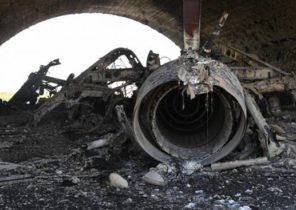
In 2021 and 2023, NASA will launch two spacecraft called “Lucy” and “Psyche.” “Lucy” will visit the Trojan asteroids, and “Psyche” will fly to a lonely asteroid of pure metal.
Now NASA is engaged in the creation of two space probes — “Lucy” and “Psyche” — whose job it is to enlighten us, how did the Solar system, visiting a total of eight asteroids in orbit around Jupiter from 2025 to 2033.
The names of the probes not chosen by chance: “Lucy” — the name given to the remains of our very distant ancestors aged 3.2 million years, and it’s very good, explains the head of the project “Lucy” Harold Levison (Levison, Harold):
“These small asteroids actually are leftovers from the formation of planets, and that’s why we named our probe “Lucy” in honor of one of the human ancestors.”
Space probe “Psyche” got its name differently — after a lonely asteroid, consisting almost entirely of metal, to which it will fly.
The Kingdom Of Jupiter
Jupiter is the largest planet in the Solar system with appropriate dimensions huge force of gravity. And with this his power Jupiter controls the asteroids for miles around.
On the same orbit as Jupiter, only 60 degrees in front and 60 degrees after the planet is full captured by Jupiter of asteroids that have accumulated in the so-called Lagrange points L4 and L5 (about the Lagrange points, see end of article).
They are called “Trojan asteroids” in honor of the Trojan war. Asteroids in the Lagrangian L4 point are named after Greek heroes, and those that are at a point L5, are named after heroes of Troy. All in both groups up to a million asteroids whose value exceeds one square kilometer.
“Lucy” will become the world’s first space probe ever to visit the Trojan asteroids, and this visit, I hope scientists will be able to shed light on the formation of the Solar system. Because although asteroids and belong to the Kingdom of Jupiter, they are very different from their surroundings and from each other. This means that they probably formed in different places in the Solar system.
When the Solar system was young, planets haven’t had their present orbits, they were just moving “haphazardly”. When large, heavy planets like Jupiter, Saturn, Uranus and Neptune passed, they caused chaos among the millions of large and small asteroids, which were also in the Solar system.
Many of these asteroids ever been thrown out of the Solar system, and some of them seized the mighty Jupiter, now called the Trojan asteroids.
The story of the Solar system
Harold Levison of the project “Lucy” put it this way: “One of the striking features of Trojan asteroids is something very different. When we look at them through a telescope here on Earth, we see that they have very different colors and spectra. And therefore, we believe they will tell us something about how it arose and developed Solar system. We believe that diversity is due to the fact that the asteroids were formed in different places in the Solar system with different physical characteristics. But during the development of the system, they traveled everywhere until I ended up in orbit around Jupiter”.
Long journey “Lucy”
It’s hard to believe, but the space probe “Lucy” will visit the Greek heroes at the point L4, and then the Trojan heroes at the point L5. This is a great achievement, because L4 and L5 are at a distance of billion miles away from each other, each group on its side, so to speak.
The space probe will be launched in 2021 and during the way to L4 in April 2025 fly past little, just four kilometers magnitude of an asteroid with a suitable name 52246 Donaldson, dubbed in honor of the archaeologist who found the remains of the hominid Lucy in Ethiopia in 1974. It seems that the trajectory suddenly very well matched with the name of the probe — but then I have a question, is not the same the team that is working on the project “Lucy”, gave the name and a small asteroid?
A particular problem is the fact that “Lucy” will fly past the asteroid at a speed of over 20,000 km per hour. Therefore it would be quite a bit of time to explore each individual asteroid.
The reason is that there is no way to give “Lucy” to carry as much fuel as the probe would need to brake and slow fly past. The space probe weighs 1435 kg, and more of the weight make up tools, radios and solar panels.
In 2027, “Lucy” reaches the point L4, where the next year will fly four very different asteroid. Then a space probe leaves L4 and powerful curve will continue its journey through the Solar system from point to point L4 L5. Not weird at all that this journey will take about five years, and in March 2033, the probe will have two asteroids of size 100 square kilometers, revolving around each other.
Such binary asteroids are rare in the inner Solar system, usually they are in the Kuiper belt, beyond the orbit of Neptune — so here at “Lucy”, could be an opportunity to look at the asteroids, to which we otherwise would be very far to reach.
Psyche is an asteroid made of metal
The journey to the asteroid Psyche is another goal. It’s outer body with good size of 250 square kilometers located in the asteroid belt between Mars and Jupiter, it rotates on a slightly elongated orbit at a distance of 2.5 to 3.3 astronomical units (a.e.) Sun, which is the asteroid flies over five years.
It sounds amazing, but Psyche is the only known asteroid, which presumably consists of pure metal. There is a version that Psyche began its existence as the core of a small planet, which was at least 500 km in diameter, and possibly almost as big as Mars.
When the Solar system was still a “child”, there were many collisions between planets and asteroids, and there is a theory that the planet, whose part was Psyche, after one or more major clashes lost their stony shell, so that left only the core.
The only problem with this otherwise great theory is that the remains of the shell had to be preserved at almost the same orbit as the Psyche, Recalling the usual stone asteroids. But nothing such was found.
Water on the surface and molten metal core
In any case, the Psyche is for us a unique opportunity to see the metal core of the planet. We know that the Earth has a core of liquid metal that produces a magnetic field, but there is no way to go down. But we can send a space probe to travel 300 million kilometers.
Space probe “Psyche” will be launched in 2023 and will reach its goal in five years. The probe will be controlled using the ion engine that will enable it to enter orbit around the asteroid Psyche and study it with a 2028 and 2030.
It will be an exceptional experience, because we’ve never seen a planet of pure metal. Looks like a crater from the impact? Will the droplets of molten metal, scattered upon impact, freeze again before you fall back?
It was surprising to find traces of water on the surface, but it may be associated with collisions with small asteroids containing ice.
But the most important question, of course, is associated with magnetism. Today it is assumed that the magnetic field resulting from the rotation of the metallic cores inside the planets large enough to have melted at least part of the metal core.
Psyche with high probability remained quite a small planet, which is unlikely to have sufficient size for the liquid core. So it is very interesting to know whether she traces the magnetic field from the days when she was the center of the planet, or the words of the expert in this area Lindy Elkins-Tanton (Lindy Elkins-Tanton): “will the Psyche a little magnet on the fridge in the middle of space?”
The Lagrange Point
Like all planets in our solar system, Jupiter has five so-called Lagrange points. This is the place where a small body will follow the planet so that the planet it will look stationary.
Those asteroids that will visit “Lucy” are in the L4 and L5 points, 60 degrees up and 60 degrees after Jupiter, but on the same orbit, and the planet itself.
Moving with the same speed as the planet
A common misconception is that the forces that affect the small body, balance each other in the points of Lagrange.
This is not so. In each of the five points small body is subjected to gravitational force of the planet (here Jupiter) and the Sun.
These five points are characterized in that the sum of these forces in them is that the small body begins to turn around the Sun with the same speed as the planet and therefore follows her.
This, however, is valid only when the body is so small that can be neglected by its own gravitational force — and this condition asteroids perform well.
L4 and L5 stable points
L1, L2 and L3 are unstable points, small body can quite quickly to get off them away. However, they may well be back again, if you use some fuel.
L4 and L5 are stable, and this means that if a small body is not exactly hit one of the two points, it can enter orbit around a point.
That is why L4 and L5 in the system Sun-Jupiter is so large that can accommodate more than a million asteroids. The asteroids are not in the points, and in orbits around them.







